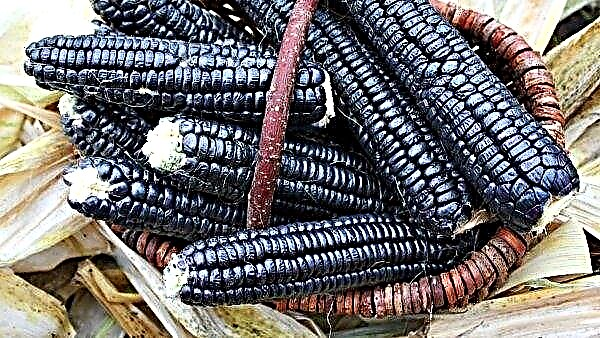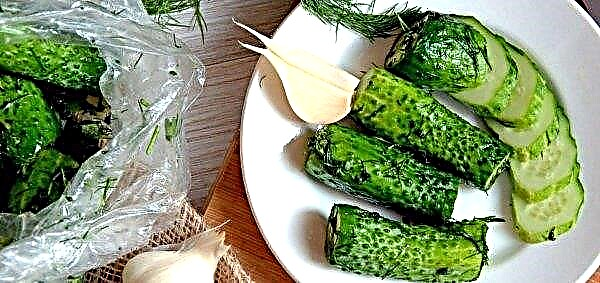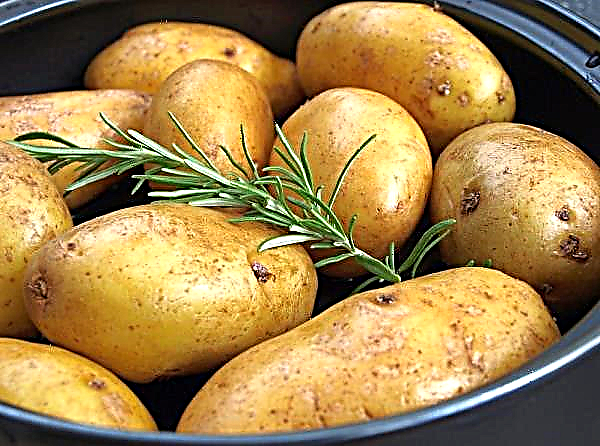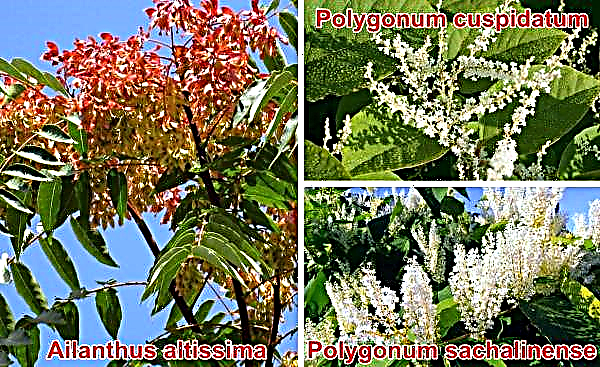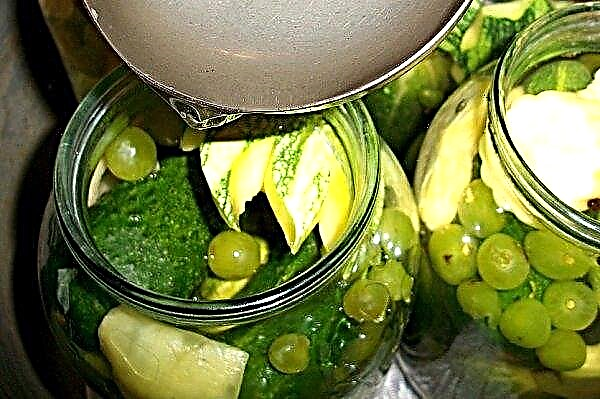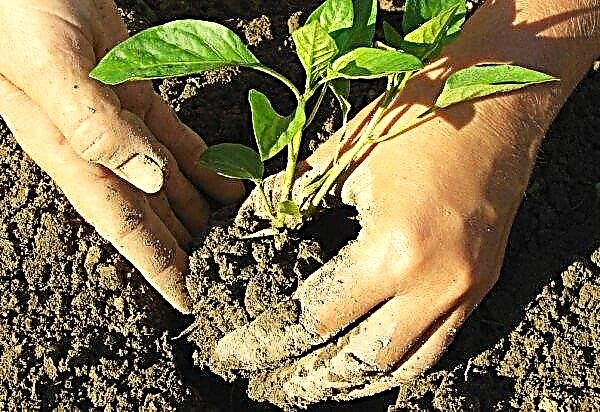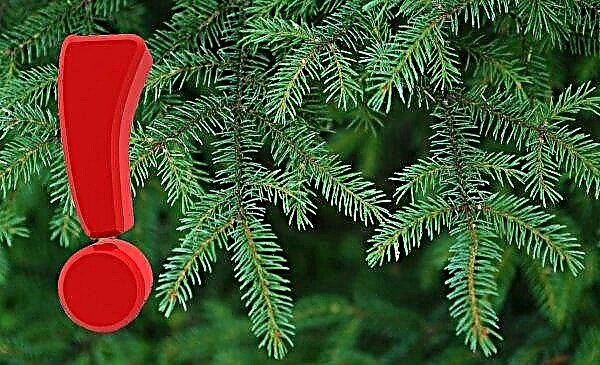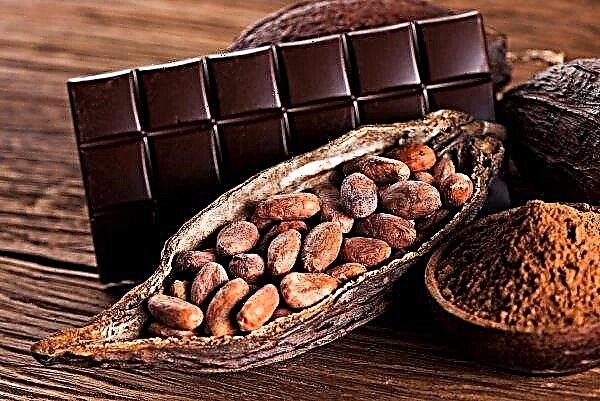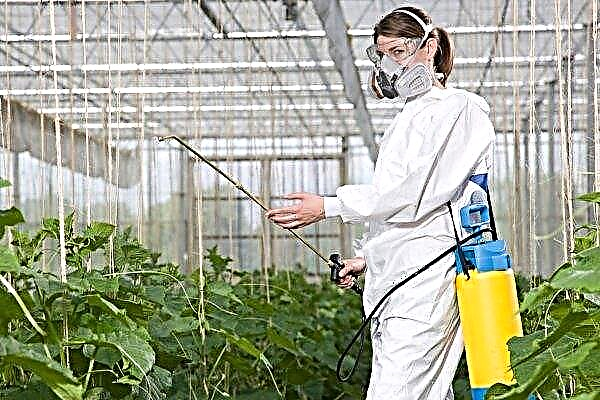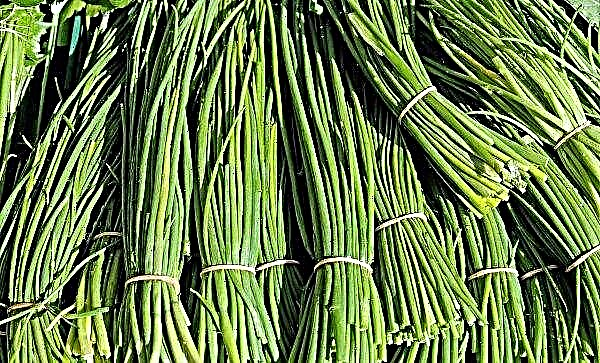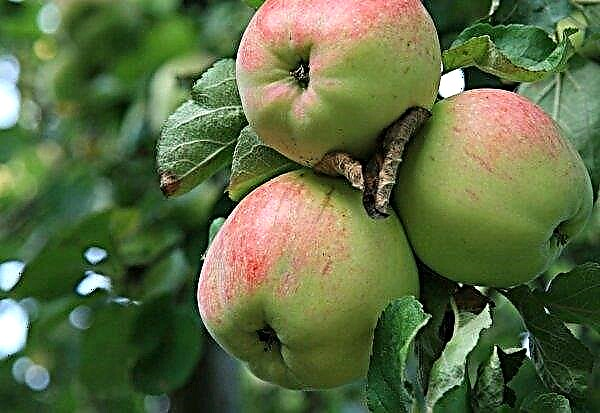Cows are divided into meat and dairy species (depending on the characteristics of the animals). Breeds of meat and milk (mixed) direction are also distinguished. The characteristics of the most popular are presented in this article.
Dairy breeds of cattle
Dairy animals are characterized by a large volume of milk produced per kilogram of live weight.
Such an animal is characterized by:
- lean build with weak muscles;
- "Triangular" body when viewed from above (with extension to the back);
- long neck and same long legs, straight back;
- large udder with embossed veins and large nipples.
Maximum milk yield is 5-6 calving. The cows of the dairy group are calm, they are adapted to various conditions of detention.Did you know? At the first lactation, the productivity of the heifers is approximately 60% of the average.

Ayrshire
This is a Scottish breed. It is officially registered in 1862. Animals are well adapted to cold climates, economical in nutrition, characterized by early maturity and potentially early insemination. Great for personal household plots. The bones of the animal are thin and strong, and the body is angular with a large bath-like udder. The color of the skin is mottled - red-white.
Important! Ayrshire cows are difficult to characterize, they are fearful and even aggressive.
They gain weight quickly: heifers - up to 480 kg, bulls - up to 800, calves are born with a weight of 25-30 kg, and in a year they increase weight up to 250 kg. The yield of meat is 50-60%, and delicious milk can be obtained up to 7000-8000 liters per year.
Red-motley
Until 1998, it was considered a type of Holstein, which it looks like. The breeding used simmental genes. The color of the animal is red-motley, and its growth reaches 1.4 m. The udder is cup-shaped. Maintenance does not require special conditions, but accurate adherence to feeding and milk yield is required to achieve optimal performance.
The weight of an adult cow can reach 680 kg, a calf is born 33–37 kg. The meat yield during fattening of castrati bulls is up to 60%. Milking - 5000-6000 liters with a fat content of up to 3.8%.
Black and white
The result of crossbreeding of local Russian and Dutch cows. One of the most common breeds, whose popularity is explained by excellent milk yield and good meat characteristics. The animals are large, the body is elongated, with a wide back; the udder is also large, asymmetrical. Height - 1.3 m. They require a large amount of feed.
The weight of a bull reaches 900 kg, cows gain up to 650 kg, and calves are born with a weight of 35 kg. Dairy indicators range from 5500 to 8000 liters per year with 3.7-3.9% fat. Slaughter meat yield - up to 55%.Yaroslavskaya
The breed is over 200 years old. Relatively small animals up to 1.3 m tall, the body is angular, black in color with white spots on the head, stomach and legs. The muscles are weak. Nipples on the udder are characteristically spaced: the front is wider than the rear. It feels great in different climatic zones.
The weight of the cow is fixed in the range of 450-550 kg, the bulls gain 600-800 kg. A newborn calf weighs 28–32 kg, its daily gain is about 750 g. Milking depends on feeding and, averaging 2700–3500 l, can reach 5500–6000 l per year. High fat milk - 4.5%. The meat yield is small: 43% for cows and up to 52% for castratus bulls.
Dutch
First mentioned in the XVII century. Thanks to selection, modern animals have a strong build with growth up to 1.35 m and excellent milk production. The color is black and white. The Dutch gave their genes to almost all breeds of the dairy type. Animals are characterized by early maturity.
Dutch bulls reach 900-1000 kg, cows can weigh from 550 to 750 kg, and newborn calves show about 40 kg. The average annual milk yield is 4000-5000 liters with a fat content of 4%. When fattening, you can get up to 60% of high quality meat.
Red steppe
The Ukrainian breed was bred at the end of the 18th century, and by the end of the 20th century it was improved due to crossbreeding with the Danish and Angler ones. These are animals whose body is red, long, with a rounded udder. It differs from other breeds in the presence of light horns and black hooves. Growth - up to 1.3 m. It quickly acclimatizes in different regions. In arid areas, it is more resistant to disease than other breeds.
The bull weighs 900 kg, the cows 470–520 kg, and the calf is born weighing about 25–30 kg. At the age of one year, the animal weighs 240–260 kg. Milk productivity - up to 4,500 liters per year with a fat content of 3.6-3.8%. The meat of these steppe cows is tasty, its yield is about 53%.
Holstein
North American breed. It is registered in 1983. Animals of black and white color are tall (cows - up to 1.45 m, bulls - up to 1.6 m). Tightened udder with a characteristic vein pattern. Reach puberty after one year. They require a large amount of high quality feed. Stressed. Not suitable for harsh climates.
The weight of bulls is about 900 kg, cows gain 600-700 kg. With good nutrition, weight can increase by 200–300 kg. Calves at birth weigh from 38 to 50 kg. The meat of gobies is considered dietary and has an excellent taste, its yield is 55-60%. The milk yield reaches 7500 liters, and the milk fat content is 3.8%.Important! The Holstein breed is characterized by pure breeding, and when crossed with others, it can produce weak offspring.

Jersey
One of the oldest breeds native to the English island of Jersey. Small animals 1.25 m tall with beautiful honey-colored coat. The characteristic shape of the head and muzzle resembles a deer. A conveniently shaped udder is great for milking. Keeping animals simple, they are undemanding to feed. Diseases of the legs are rarely affected.
The weight of an adult bull reaches 800 kg, the average cow weighs 400–500 kg, and the calf is born with a weight of 25 kg. Milk has an excellent taste and high fat content (6–7%), the separation of the creamy part is quick, with a clear separation. Annual milk yield is 5000–5500 liters. The meat yield is up to 55%, the taste is medium.
Kholmogorsk
Russian breed with a long history. The body is angular, the chest is deep, the coat is black and white (very rarely red-mottled). The udder is small and symmetrical. They take root well in harsh conditions and are resistant to many infectious diseases.
Cows gain up to 590 kg of live weight, bulls - up to 950 kg, calves - from 30 kg. Milk is 3,500-4,000 liters per year with a fat content of 3.7%. The meat yield is up to 50%.
Tagil
As a result of crossbreeding with Dutch women and hillocks, Tagil cows significantly improved their productivity. They can have any color. These animals are up to 1.3 m tall, with a strong constitution and different muscular structures (both powerful and baggy). Bulls have small horns, and cows are almost hornless.
The average weight of a Tagil bull is 750–900 kg, cows 450–500 kg, and a newborn calf 30–35 kg. The annual milk yield is fixed at 3,500–4,000 liters with a fat content of 4–4.5%. Meat yield up to 60%.
Meat breeds
Cows of meat direction should provide maximum weight gain with optimal, from an economic point of view, feeding.
Signs of animal meat are obvious:Did you know? Most giant bulls live in the UK today. For example, a Charolais Field Marshal bull weighs more than 1.7 tons with an increase of 1.9 meters (according to 2008).
- strong addition of a rectangular shape (side view and top view);
- uniform development of the front and back;
- powerful breasts and developed hips;
- large size and high growth;
- undeveloped udder in cows;
- thick skin.

Limousine
French animals from the Limousin region, where their breeding began in the middle of the 18th century. The body is massive, with medium strong legs and a small udder. The neck is short, the head with a large forehead. The color of the skin is golden brown. Unpretentious and frost-resistant, with easy calving. Bulls are aggressive (like calving cows, growing calves).
The weight of the bull can be more than 1.3 tons, and cows do not gain more than 700 kg. Calves are born weighing 40 kg and grow 0.8-1 kg per day. High-quality meat with a low fat content and a yield of 60–65%. Milking is low (1300-1800 liters per year with a fairly high fat content of up to 5%).Charolais
The massive breed from France has been known since the 17th century. Actively crossed and was selected for growth and weight. A cow is much smaller than a bull. The color of the skin is from milky to brown. The body is rectangular, the neck with large skin folds. Animals grow up to 2 years, reaching a growth of 1.6 m.
The weight of the champion bull is 2 tons (an average of 1–1.6 tons). Cows gain up to 750 kg with growth up to 1.55 m. Calves are born weighing up to 70 kg (minimum 30).
The breed is characterized by good milk production - 2000-4000 liters with a fat content of 3.5-4.5%. The meat yield is up to 65%. Sharolezsky beef - lean meat of gentle taste.Important! The high weight of calves often leads to birth injuries and a high mortality rate.

Hereford
English cows have been known since the 18th century. Animals of red color with white spots. The body is squat, with powerful legs and a broad back. Unpretentious in care, with stable immunity. Calves are highly viable. The meat is "marble", excellent taste.
The average weight of a Hereford bull is 1 ton, cows about 600 kg, a calf - 36 kg. The average meat yield is 60%, and can reach 70. The milk fat content is 4%, and the yield of milk per year is up to 1200 liters.
Kalmyk
These hardy animals are able to exist in an arid climate with sudden changes in temperature and scarce food. The physique is compact, with a broad back. The color is red with white spots, the coat is dense. May be on year-round grazing. The meat is red with yellow veins, tasty. After calving, the cows become aggressive.
A bull weighs 1 ton, a cow weighs 550 kg, and calves are born 25 kilograms. The annual milk yield is 1000–1200 liters, the fat content is 4.5%.
Belgian blue
A breed with a characteristic appearance and unlimited mass growth. Animals are distinguished by hypertrophied muscles, thin skin and rare coat of white-blue color. The character is calm, the immunity is unstable. Not suitable for northern regions. Need help with hotel.
An adult bull weighs up to 1.25 tons, a cow - 900 kg. Demonstrate a fairly high dairy performance - up to 4500 liters per year. The yield of meat from the Belgians is 70–80%. Beef with a low fat content, great taste.Important! To obtain optimal mass growth, it is necessary to adhere to a special feeding of calves with milk up to 2 months.

Kazakh white-headed
Animals are well adapted to local conditions, were crossed with Hereford and Kalmyk individuals. Strong physique, with massive hips and a broad back, Hereford color. Hardy and unpretentious, they perfectly tolerate the harsh climate. The meat with excellent taste, "marble".
Calves are born with a weight of up to 27 kg and grow with a gain of up to 1 kg per day. Cows gain up to 600 kg, and bulls - up to 1 ton. Meat yield - 60–65%, milk yield - up to 2000 liters per year with a fat content of 3.8%.
Galloway
The Scottish breed was bred in the XVII century. Black suit, occasionally dark brown or grayish yellow. The wool is voluminous, sheep type, up to 20 cm long. Without horns. Withstands harsh climatic conditions. The cow is unpretentious to diet and care, precocious. Marble meat, high quality.
The mass of an adult bull is up to 800 kg, cows - up to 500 kg. A calf is born with a weight of up to 27 kg. The meat yield is over 65%. The average annual milk yield is up to 1,500 liters.
Aberdeen Angus
The breed was bred in Scotland in the 19th century. Hornless animals of black or red color with short legs and pronounced meat forms. The bones are thin. Animals quickly build up mass and take first place in the precocity and quality of meat. They can be outdoors even in frost. The meat with excellent taste, different marbling, is considered the best choice for steaks.
The mass of the bull is up to 1 ton; cows weigh 500–700 kg. Calves are born weighing up to 25. The meat yield is approximately 60%. Milk yield up to 2000 liters per year. Up to 480 kg, bulls - up to 800 kg, calves - 25-30 kg (increase weight up to 250 kg per year). The yield of meat is 50-60%, and tasty milk with a fat content of 4% can be obtained up to 7000-8000 liters per year.
Meat and dairy breeds
Rocks of mixed direction are characterized by:
- universality of application;
- simple care and feeding;
- quick adaptation to different conditions;
- the possibility of mating with any type of breed.
Meat and dairy breeds are not demanding on nutrition and are suitable for cultivation in the northern regions.Did you know? The life span of a cow depends on the country of residence. According to tradition, centenarians – originally from India, where cows are considered sacred and live up to 20 years.

Krasnogorbatovskaya
The result of crossbreeding of local Russian and Tyrolean animals. They differ in small growth (in the region of 1.2 m). The elongated body shape with narrow breasts is combined with a small but well-developed udder. The body color of the animal is red, interspersed with white. Animals are characterized by resistance to many diseases, including infectious diseases (leukemia, tuberculosis and brucellosis are ill in exceptional cases).
Weight gain is average: cows reach 600 kg, bulls - 900 kg, calves are born weighing 25–28 kg. The meat yield is 55%. Milk yields average 3000 liters per year. Milk is high in fat (4.2–6%).Important! The breed shows good productivity on free grazing (without compound feed and additives), but the structure of the udder is poorly suited for machine milking.
Kostroma
Check out more

Weight gaining fairly quickly: bulls reach 900 kg, cows - up to 700 kg, calves weigh about 40 kg. The meat yield is up to 65%.
The advantage of this breed is the high milk yield: 4000-7000 liters per year. Milk of medium fat content (3.9%), the percentage of lactose is high (approximately 5%).
Bestuzhevskaya
Known since 1780, when it was bred in the Ulyanovsk region of Russia. Its genes contain both local and European individuals (shorthorns and Dutch). Animals have medium height (up to 1.3 m) and strong build. Color red (sometimes light and dark). They are immune to leukemia, tuberculosis and other diseases. A cow can eat coarse feed, due to which it is considered economical.
Weight gain is quick: bulls reach 1 ton, cows - 400-700 kg, calves - 36 kg. The meat yield varies from 55 to 60%. "Bestuzhevki" demonstrate milk yield, which can be compared with dairy breeds. For a year, a cow can produce up to 5000 l (minimum 3000) of delicious milk with a fat content of up to 4%, and with improved feed - up to 5.5%.
Simmental
The Swiss breed has been known since the beginning of the 19th century. It is divided into several subspecies at the place of distribution (northern, steppe, Far Eastern). The animals are distinguished by a powerful physique with a short neck and a wide chest, and growth at the withers is 1.4–1.5 meters. The skin color is mottled, fawn, red and red, and the head is most often white.
Animals quickly gain weight: bulls can weigh about 1 ton, heifers - 600–700 kg, and newborn calves - 40–45 kg. During the first year of life, the weight gain is up to 400 kg. Simentals are characterized by a high yield of meat - 68–70% in adults and 55% in young people, but it contains a lot of bones. Milk yield is 3500-4000 liters per year, and its fat content is 4%.
Shvitskaya
One of the oldest breeds native to Switzerland of the XIV century, the breed is distributed throughout Europe. It gained popularity due to its unpretentiousness in care and nutrition and good performance. Animals of light (blue or gray) color with dense coat well take root in cold areas. Adult growth is up to 1.3 m, and chest width is up to 70 cm.
Schweiz cows grow very quickly: in the first year, calves gain up to 400 kg (from an initial weight of 39 kg). The maximum weight of a bull is 1 ton, cows 550–800. The meat yield (58–60%) is combined with a rather high milk yield of 4000–4500 liters per year.The milk fat content is 3.8%.
The variety of cattle breeds allows you to choose the best animals for growing in various conditions, depending on the desired direction. Modern breeding continues to improve the characteristics of cows in order to maximize the benefits for breeders.


